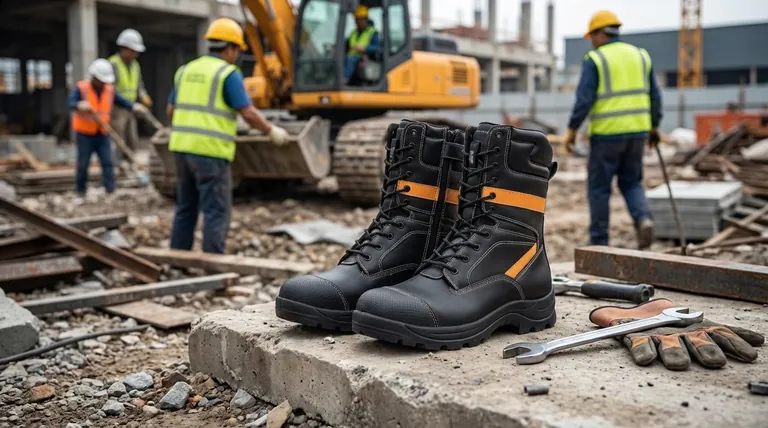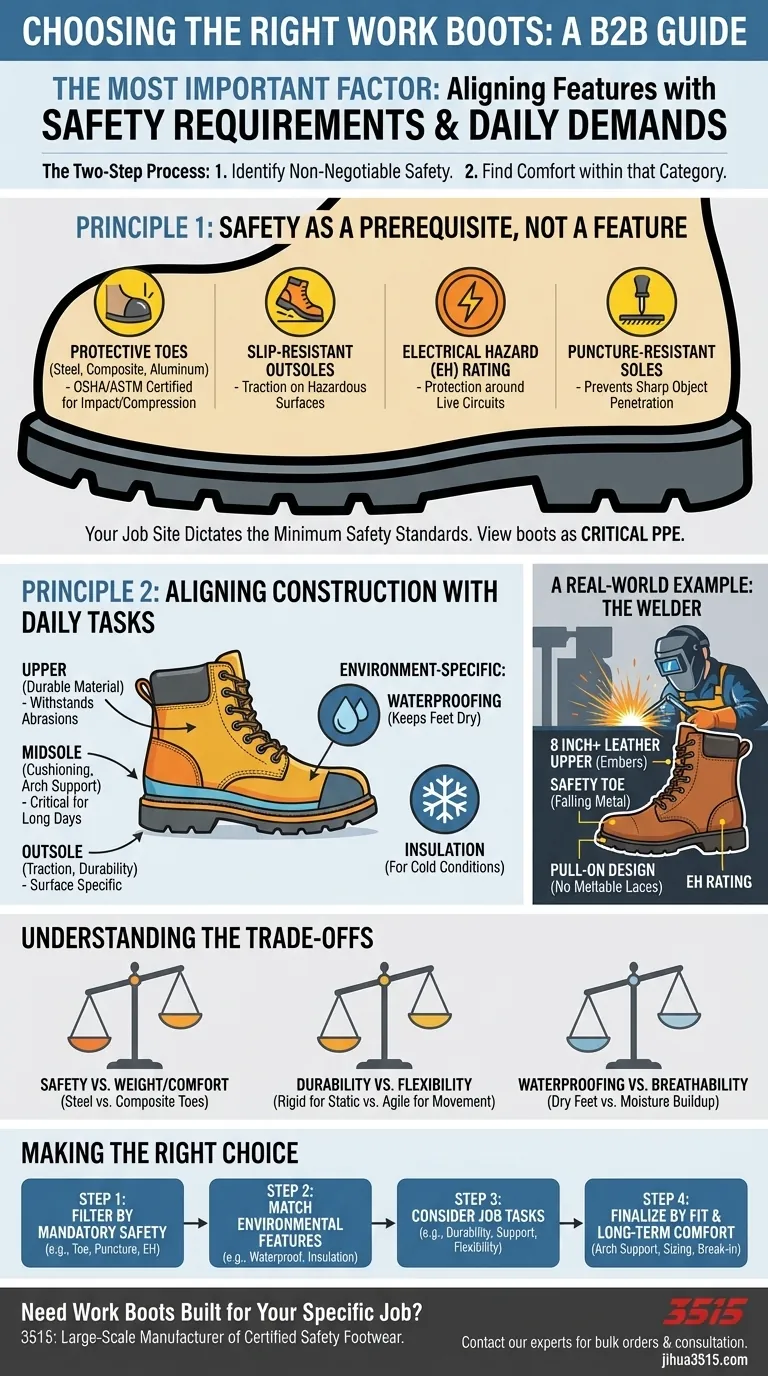The single most important factor to consider when purchasing new work boots is how their specific features align with the mandatory safety requirements and daily demands of your job. While many focus on comfort, true performance starts with selecting a boot that is fundamentally designed for your specific work environment and its inherent risks.
The search for the right work boot isn't about finding the "most comfortable" or "safest" pair in a vacuum. It's about a critical two-step process: first, identify the non-negotiable safety features your job requires, and second, find the most comfortable and supportive boot within that specific category.

First Principle: Safety as a Prerequisite, Not a Feature
Before you can even consider comfort or style, you must view safety as the foundational requirement. Your boots are a critical piece of Personal Protective Equipment (PPE), and their primary job is to mitigate workplace hazards.
The Non-Negotiable Safety Core
Your job site dictates the minimum safety standards. Key certifications from the Occupational Safety and Health Administration (OSHA) and ASTM International provide a clear benchmark for protection.
Key features to verify include protective toes (steel, composite, or aluminum) for impact and compression resistance, and slip-resistant outsoles for traction on hazardous surfaces.
Specialized Hazard Protection
Many jobs have unique risks. If you work around live circuits, an Electrical Hazard (EH) rating is essential. If you risk stepping on sharp objects, look for puncture-resistant soles.
Think of it like this: you wouldn't bring a hammer to a job that requires a wrench. Choosing a boot without the correct safety rating is making the same fundamental mistake.
Second Principle: Aligning Construction with Your Daily Tasks
Once the baseline safety requirements are met, you can analyze the boot's construction. The materials and build quality determine its durability, support, and suitability for your environment.
The Upper, Midsole, and Outsole
The upper (the material covering your foot) needs to withstand the abrasions of your job. The midsole provides cushioning and arch support, which is critical for long days on your feet. The outsole provides traction and durability against the surfaces you walk on.
Environment-Specific Features
Working in a wet climate demands waterproofing, which keeps your feet dry from the outside. If you work in the cold, insulation is necessary to maintain a safe and comfortable foot temperature.
A Real-World Example: The Welder
A welder's boot choice perfectly illustrates this principle. They need a high leather upper (8 inches or more) to protect against falling embers, a safety toe for falling metal, and often a pull-on design to avoid laces that can be burned or melted. An EH rating is also common. Comfort is important, but only after these job-specific needs are met.
Understanding the Trade-offs
There is no single "best" boot, only the best boot for a specific application. Every design choice involves a compromise, and understanding these helps you make an informed decision.
Safety vs. Weight and Comfort
Steel toes offer maximum protection but add significant weight. Composite toes, made from materials like carbon fiber or plastic, are much lighter and don't conduct cold, but they can be bulkier.
Durability vs. Flexibility
A rigid, heavily-constructed boot may offer incredible durability and support for static work but can feel cumbersome for jobs that require agility, climbing, or constant kneeling.
Waterproofing vs. Breathability
A fully waterproof membrane is excellent at keeping water out, but it can also trap sweat inside, leading to moisture buildup and discomfort in warm conditions. You must balance the need for water resistance with the need for your feet to breathe.
Making the Right Choice for Your Goal
Filter your options first by safety requirements, then by features that match your environment, and finally by personal comfort and fit.
- If you work in construction or heavy industry: Prioritize certified toe protection and puncture-resistant soles above all else.
- If you work outdoors in varied climates: Focus on high-quality waterproofing and an appropriate insulation level for your region.
- If you work with or around live electrical circuits: Ensure your boots have a clear Electrical Hazard (EH) rating as a non-negotiable feature.
- If your job requires constant movement and long hours on your feet: Once all mandatory safety needs are met, make proper fit, cushioning, and arch support your final deciding factors.
Ultimately, the right work boot is the one that protects you from your job's specific hazards while providing the support you need to perform effectively all day long.
Summary Table:
| Key Factor | Why It Matters | Key Features to Look For |
|---|---|---|
| Safety & Certification | Non-negotiable protection against job-specific hazards. | ASTM/OSHA certified safety toe, EH rating, puncture-resistant sole. |
| Job-Specific Construction | Ensures durability and support for your daily tasks. | Upper material (e.g., leather), midsole cushioning, slip-resistant outsole. |
| Environmental Suitability | Keeps feet comfortable and protected from the elements. | Waterproofing, insulation (for cold), breathability (for heat). |
| Fit & Long-Term Comfort | Critical for all-day performance and injury prevention. | Proper arch support, correct sizing, break-in period. |
Need Work Boots Built for Your Specific Job?
As a large-scale manufacturer, 3515 produces a comprehensive range of certified safety footwear for distributors, brand owners, and bulk clients. Our production capabilities encompass all types of shoes and boots, ensuring you get the exact combination of safety, durability, and comfort your workforce requires.
Contact our experts today for a consultation on your next work boot order. We'll help you select or customize the perfect footwear solution to protect your team and enhance productivity.
Visual Guide

Related Products
- Premium Flame-Retardant Waterproof Safety Boots and Shoes
- Heavy Duty Nubuck Safety Boots Safety Shoes for Global Distribution
- Premium Sport Style Safety Boots for Bulk Orders
- Premium Suede Sport Safety Shoes for Wholesale & Bulk Orders
- Advanced KPU Athletic Safety Shoe with Steel Toe Cap Anti-Slip Rotary Lacing System
People Also Ask
- What are the advantages of rubber soles in safety boots? Unbeatable Grip & Durability
- What are the benefits of proper safety footwear beyond physical protection? Boost Productivity & Morale
- What features make oilfield safety shoes resistant to heat and flames? Protect Against Extreme Temperatures
- What potential foot injury hazards exist in workplaces? A Guide to Mitigating Common Risks
- What factors should be considered when choosing the appropriate type of safety footwear? A Guide to Maximum Protection



















